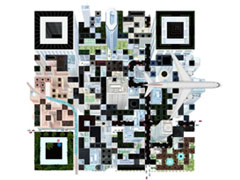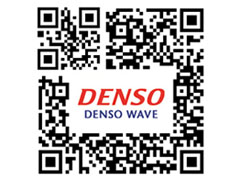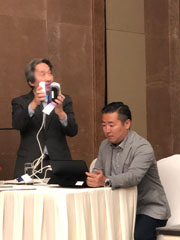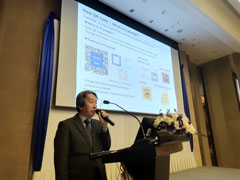- Home
- Countries & Regions
- Asia
- Myanmar
- Press Release
- JICA and Denso Wave to showcase latest QR Code® technologies for proper expansion in Myanmar: By having "the Father of QR Code" as the key resource
Press Release
January 10, 2020
JICA and Denso Wave to showcase latest QR Code® technologies for proper expansion in Myanmar: By having "the Father of QR Code" as the key resource
The Japan International Cooperation Agency (JICA) and Denso Wave Incorporated (Denso Wave) are seeing the potentials of QR Code in financial inclusion and success of business in Myanmar by having over 200 stakeholders, which includes 44 banks (including state, private and foreign banks), 5 mobile payment financial institutions and related ministries. This is about the JICA project for "Modernizing the Funds Payment and Securities Settlement Systems in Myanmar" in collaboration with, Denso Wave and Mitsubishi Research Institute, Inc. (MRI) hosted workshops on "QR Code Technologies" in Yangon and NayPyiTaw on 9th and 10th January.
Mr. Hara Masahiro, being known as the Father of QR Code visited Myanmar all the way to share the features of QR Code. He presented the evolutional history of QR Code as well as its business use; namely, in factories, airports, railway tickets, bank counters, musical theatre, and payments. Mr. Hara also talked about security risks that may come with the use of QR Code such as scams and cybercriminals. Mr. Hara says "QR Code is so simple, easy and cheap to use but it needs to be proper understanding of threats and taking necessary preventive actions by users and service providers. In fact, there are many cases that QR Code is using properly and safely in the market." During the session, the latest technologies such as Face Recognition SQRC® were also demonstrated by Mr. Yasui Kengo, Sales Marketing Manager in Denso International ASIA.
The QR Code was invented in 1997 by Denso Wave, a Japanese automotive giant TOYOTA Group Company. The QR Code has greater capacity in storage, quick reading, and data recovery compared to other 2D codes such as UPC barcodes. The use of QR Code is free as long as users follow the standards for QR Code documented with JIS or ISO (Thanks to Denso Wave!). The QR Code then evolved into Micro QR (‘98), SQRC® (‘07), iQR code® (‘08), Anti-Copying QR code (‘12), and FrameQR® (‘14) to meet a variety of needs in industries of factories, promotion, ticketing, and payments. Since its registry in ISO (ISO/IEC18004) in 2000, QR Code is now used everywhere in the world, especially its flourish is popular in China.
JICA since 2013 provides assistance to Central Bank of Myanmar trying to enhance capacity of Myanmar financial sectors. Myanmar at that time ranked behind any other ASEAN countries due to lack of financial market infrastructures such as real time gross settlement (RTGS) system and government bond book entry (CSD: Central Securities Depository) system. But since the introduction of CBM-NET (Central Bank of Myanmar Financial Network System) in 2016 with support of JICA, Myanmar became one of the advanced countries in ASEAN region. The CBM together with JICA is currently working on the second generation of CBM-NET called CBM-NET2. CBM-NET2 will have 24/7 domestic MMK remittance systems as well as world-class advanced settlement tool (delivery versus payment with collateral: DVPC). Myanmar will in 2020 jump into one of only a few countries (such as Japan and the EU) to have this function in the world. The JICA project, a host of this workshop, is trying to transform remittance behavior from informal to formal channels through CBM-NET - a safe, fast and efficient payment system.
 QR Code 25th Anniversary
QR Code 25th Anniversary
 FrameQR®
FrameQR®
*To Scan FrameQR, need to download special Denso Wave App.
QR Code、iQR Code、SQRC and FrameQR are registered trademarks of DENSO WAVE INCORPORATED in JAPAN and other countries.



- Asia
- Southeast Asia
- Cambodia
- Indonesia
- Laos
- Malaysia
- Myanmar
- Philippines
- Thailand
- Timor-Leste
- Viet Nam
- East Asia
- China
- Mongolia
- Central Asia and the Caucasus
- Armenia
- Azerbaijan
- Georgia
- Kyrgyz Republic
- Tajikistan
- Uzbekistan
- South Asia
- Afghanistan
- Bangladesh
- Bhutan
- India
- Maldives
- Nepal
- Pakistan
- Sri Lanka
- Oceania
- Latin America
- Africa
- Middle East
- Europe
- Asia
- About JICA
- News & Features
- Countries & Regions
- Our Work
- Thematic Issues
- Types of Assistance
- Partnerships with Other Development Partners
- Climate Change / Environmental and Social Considerations
- Evaluations
- Compliance and Anti-corruption
- Science and Technology Cooperation on Global Issues
- Research
- JICA Development Studies Program / JICA Chair
- Support for the Acceptance of Foreign HRs / Multicultural and Inclusive Community
- Publications
- Investor Relations
